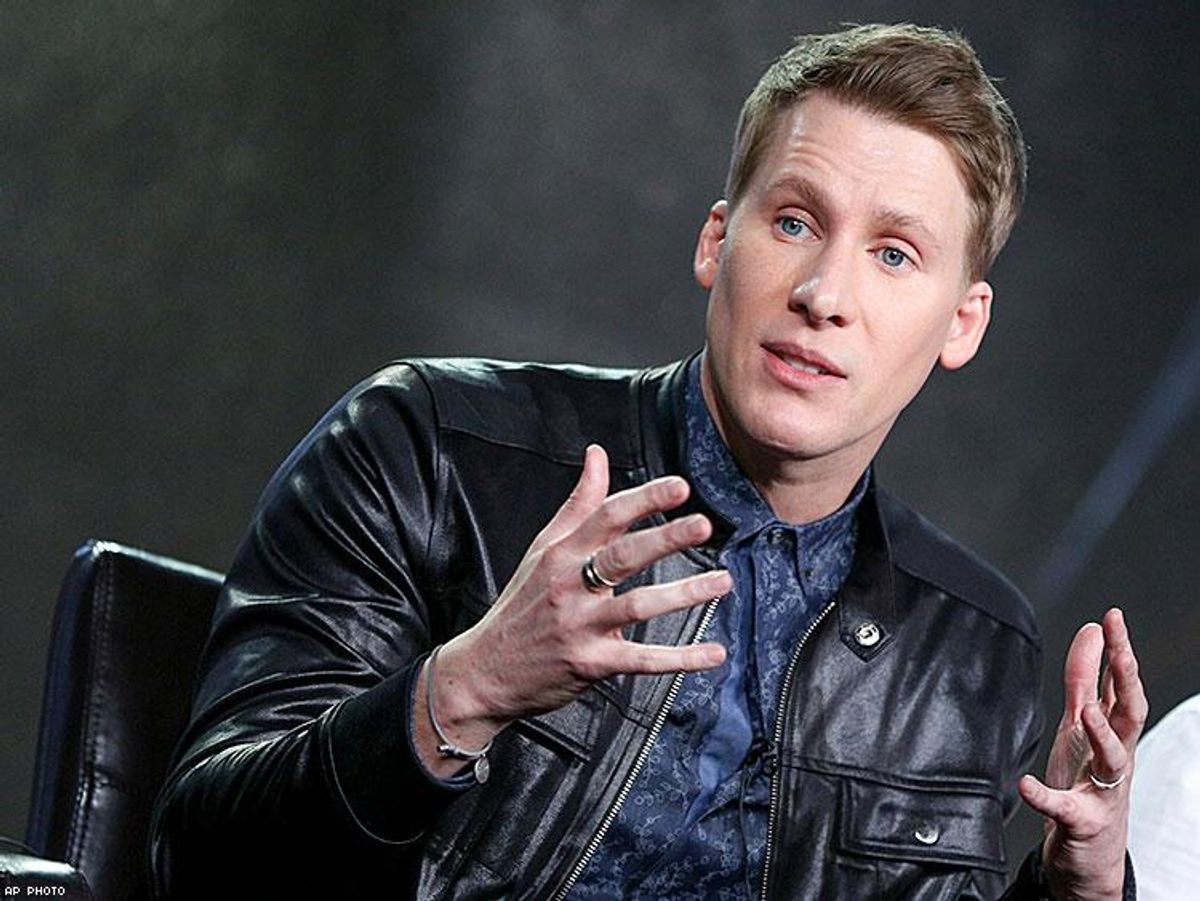Cleve Jones (Guy Pearce), speaking to a reporter in When We Rise, says, "Each generation has its own epic confrontations it must face." The message is clear: You're fighting a battle, dear viewer. But it's a battle that's been fought before. And it's one that will be fought again.
Throughout the week, ABC will be airing the miniseries created by Dustin Lance Black (Milk), which depicts decades of recent LGBT history through the eyes of Jones and other activists. There are many lessons to learn. And during the presidency of Donald Trump, who has already begun to attack transgender rights, learning them may be more essential than ever.
To this end, The Advocate discussed each episode with the gay Oscar-winning screenwriter, asking Black what LGBT viewers -- and Americans more broadly -- should take away from each "epic confrontation" that has taken place since a trans woman threw the first brick at the Stonewall Inn in 1969.
According to Black, the defining "architecture" of When We Rise, established in Monday's premiere, is intersectionality -- the belief that civil rights gains can be best achieved when members of different movements work in concert.
"It was critical to me that we portrayed not just people who come from, not just people who dedicate their lives to the LGBT rights movement, but who came from other civil rights movements," Black says.
"If you take a look at the first episode, it really examines how the movements of the '60s, that moved into the '70s, were built off a coalition between the black civil rights movement, the women's movement, and the peace movement," he continues. "Our movement, the LGBT movement, stands on the shoulders of those movements and was built by people who learned their lessons."
In the opener, viewers are introduced to three characters who are destined to become not only LGBT activists but also advocates for other vulnerable communities: a young Roma Guy (Emily Skeggs), Ken Jones (Jonathan Majors), and Cleve Jones (Austin P. McKenzie). The skills that these young people learn through the women's movement, the civil rights movement, and, later, HIV activism will all be put to the test in the years ahead for the LGBT movement.
For now, Guy, a feminist, is first seen as activist with the Peace Corps. She joins the National Organization for Women, but journeys west after this group rejects lesbians from its ranks. Ken Jones, a black sailor in the U.S. Navy, begins a desegregation program, coaching racism out of the military ranks even as homophobia prevents his public grieving of a dead lover. A teenage Jones, galvanized after reading Life magazine's 1971 coverage of the Stonewall Riots, hopes to find purpose in the budding gay liberation movement after leaving an unwelcoming father, home, and school.
All three converge on San Francisco in the 1970s, after facing some form of institutional intolerance from their respective communities. Any dreams of finding a safe haven there, however, are quickly dispelled. The mayor has declared war on the hippies, the gays, and the "us-es," as Cleve recounts, leading to clashes between protesters and law enforcement. And between the different "us-es," there are trenches. Among lesbians, there is little interest in joining forces with gay men. Gay bars have their own rules against women and people of color. These divides are signs of the times, but they also represent present-day divisions that have stubbornly remained as well as marginalization within already marginalized communities.
"There's always going to be certain groups who are being made to feel less than within a social justice movement, right? That whole idea of the oppressed becoming the oppressor," Black says. "You see that within social justice movements. You see that within the black civil rights movement, where gay men were kicked out of the black civil rights movement because they were gay. And there was supposedly no such thing as a gay black man. You see that in the women's movement with lesbians being kicked out in the late '60s, early '70s, because of the lesbian 'threat.'"
"What we have to pay attention to, the cautionary tale, is that when we do that -- when we divide ourselves, and we lose sight of the importance of our interconnectedness --that's when we suffer defeats."
The three central characters in When We Rise push back against these barriers, possessing a prescience for "our interconnectedness" that provides a model for modern-day movements. Guy invites Cleve to a women's rally, and he goes. Once there, she defends his presence among the activists; and he helps defend her from a police raid. Moreover, Cleve pushes back against an older gay activist, Jim Foster, who wants him to change his appearance and manner to conform to heterosexual standards. Ken, defying military rules, finds love with a man of another race. In the background, Harvey Milk, seen in archival footage, campaigns for office while urging LGBT people to come out and come together.
"I hope what this series as a whole says is the only way to maintain our civil rights, to push back when the pendulum swings backward, and to defeat a backlash, is to do it together," says Black, who cautions that even dearly fought-for rights are not guaranteed.
As "an LGBT movement, we can be defeated," he says. "We can lose our rights. But if we rebuild, which I don't think we have done right now, if we rebuild the coalitions, between civil rights movements and social justice movements, then we've got a shot. And I think that speaks to today in a pretty profound way."
Today, the election of Trump has galvanized these movements to come together like never before. The Women's March, in particular, was a historic show for support of women's concerns, with people representing every population present to show how diverse the faces of women in America can be.
Yet not too long ago, after the major advances in gay rights under the Obama administration -- the passage of the Matthew Shepard and James Byrd, Jr. Hate Crimes Prevention Act, the end of "don't ask, don't tell," the victory of marriage equality -- Black observed what can happen when complacency sets in among certain groups.
"Four years ago, when I started making this series, that's what concerned me, which is the myopia of the LGBT movement," he says. "We seemed incredibly self-interested. I was very pleased with the great gains we were making, but at the same time, you start to worry, how will we hold on to those gains if we're not dedicated to staying connected to our brothers and sisters and other social justice movements? Why aren't we enthusiastically marching with Black Lives Matter? Why aren't we as supportive as trans people as they have been to us in the marriage fight?"
"That's ignorance. That's blindly ignoring our history. That's blindly ignoring how we make progress," he concludes. "We must never forget those connections, if we're going to win equality and maintain those gains."
The next episode of When We Rise is Wednesday at 9 p.m. Eastern on ABC.

















































































